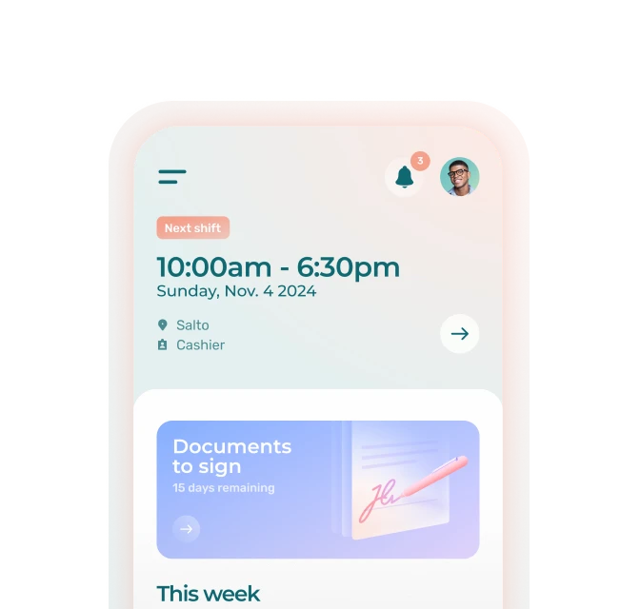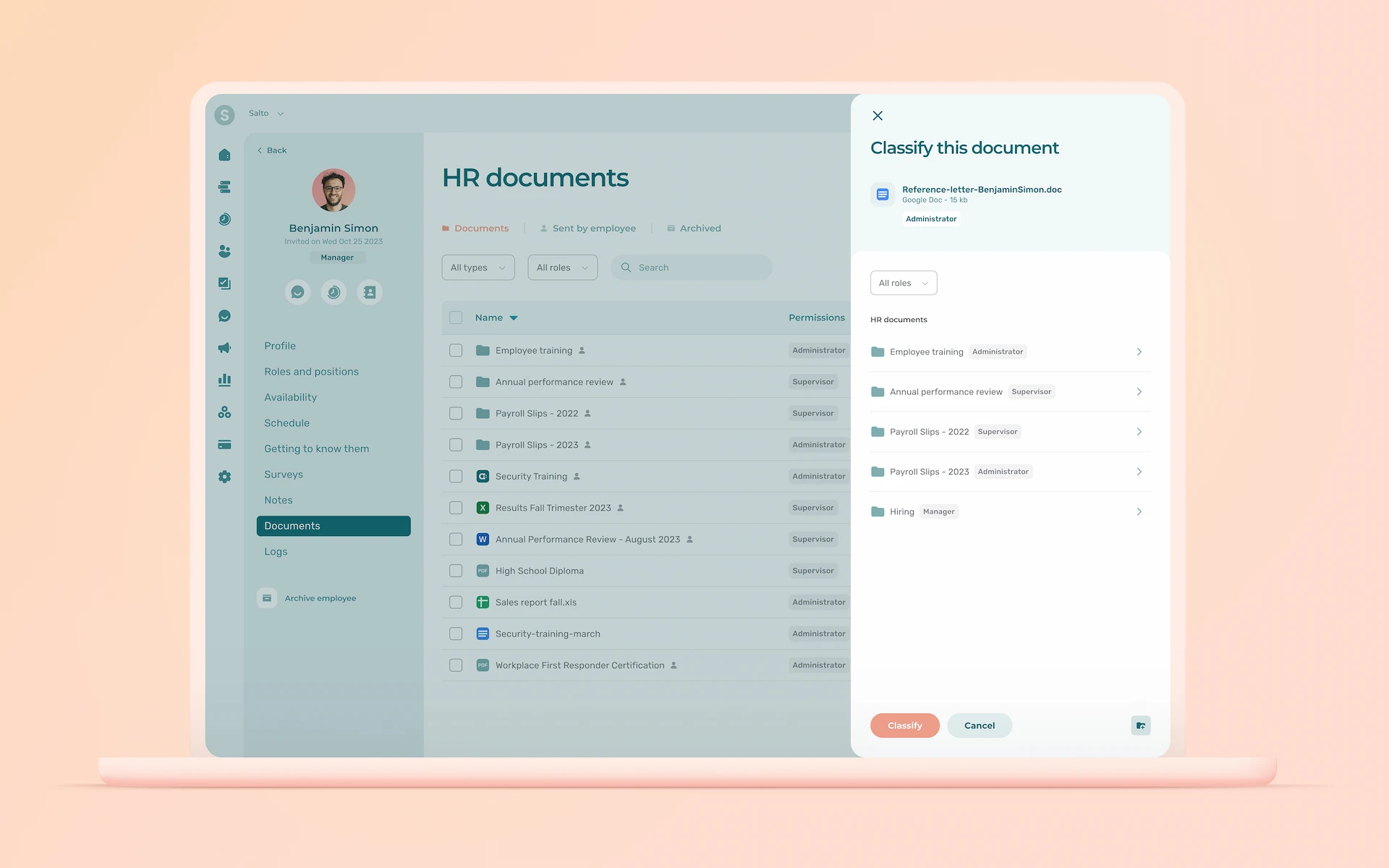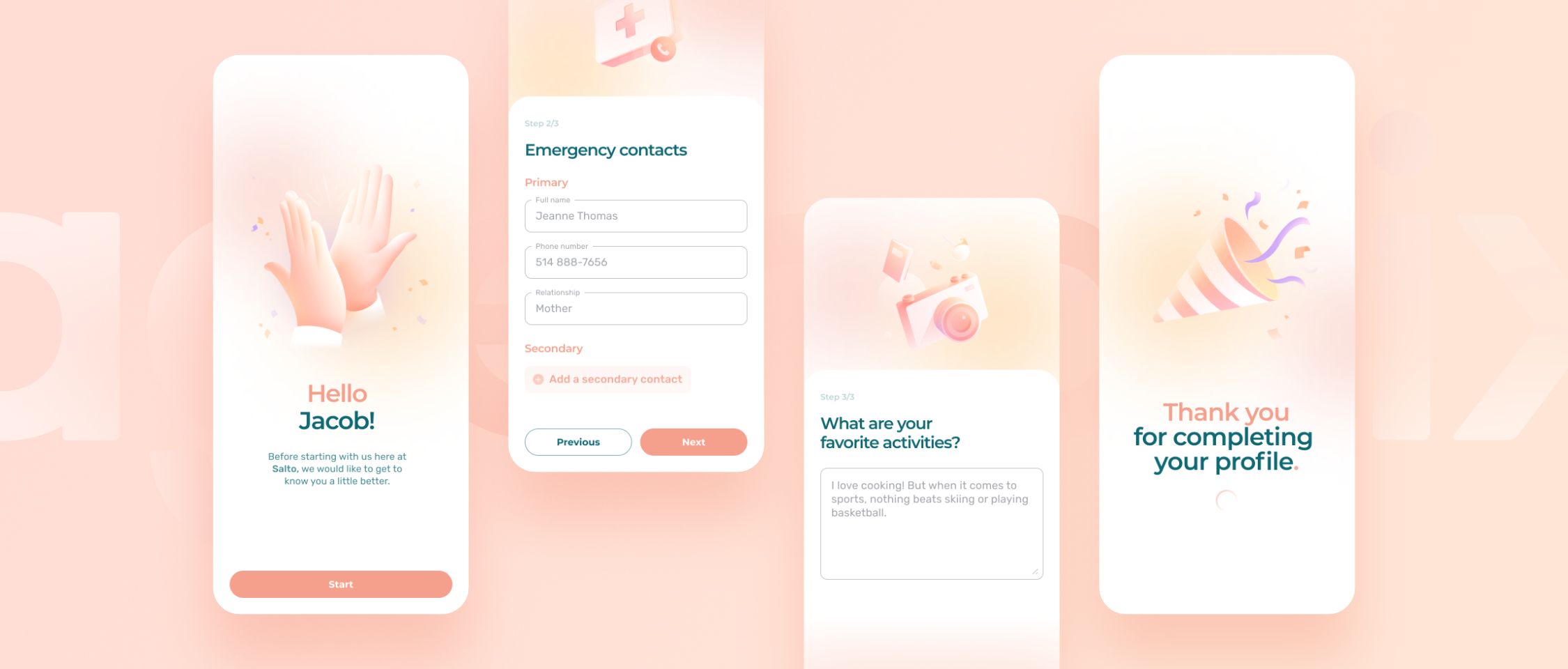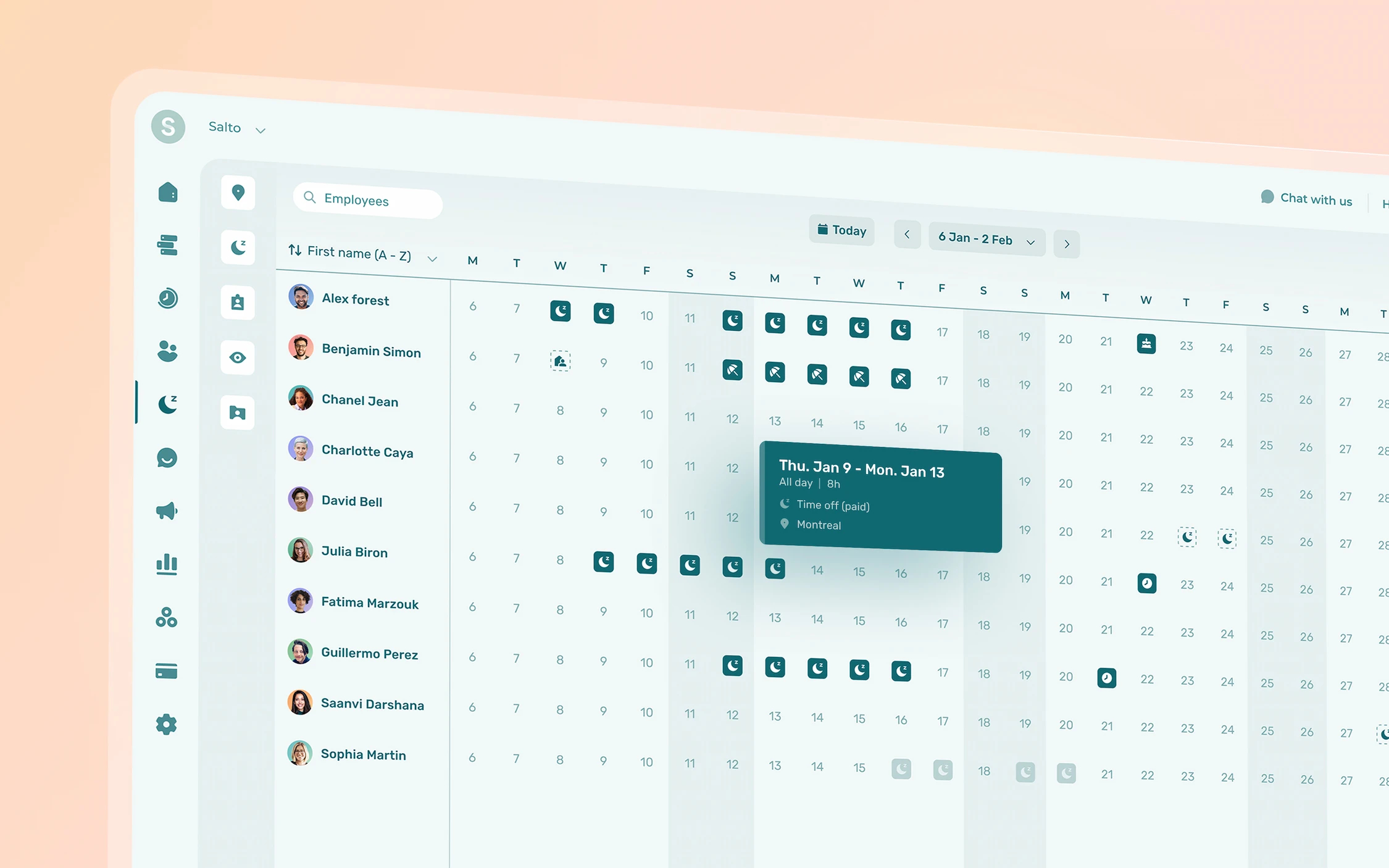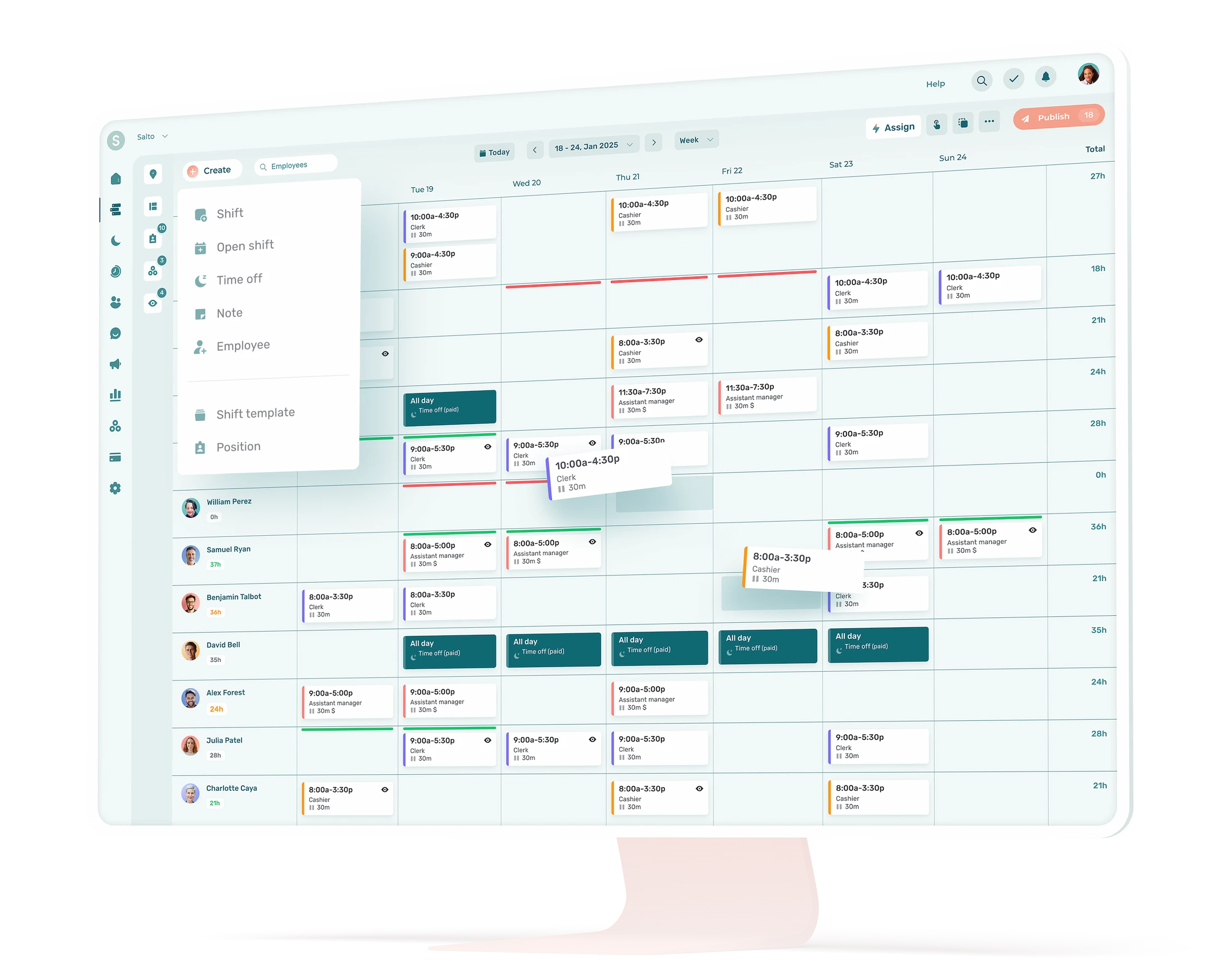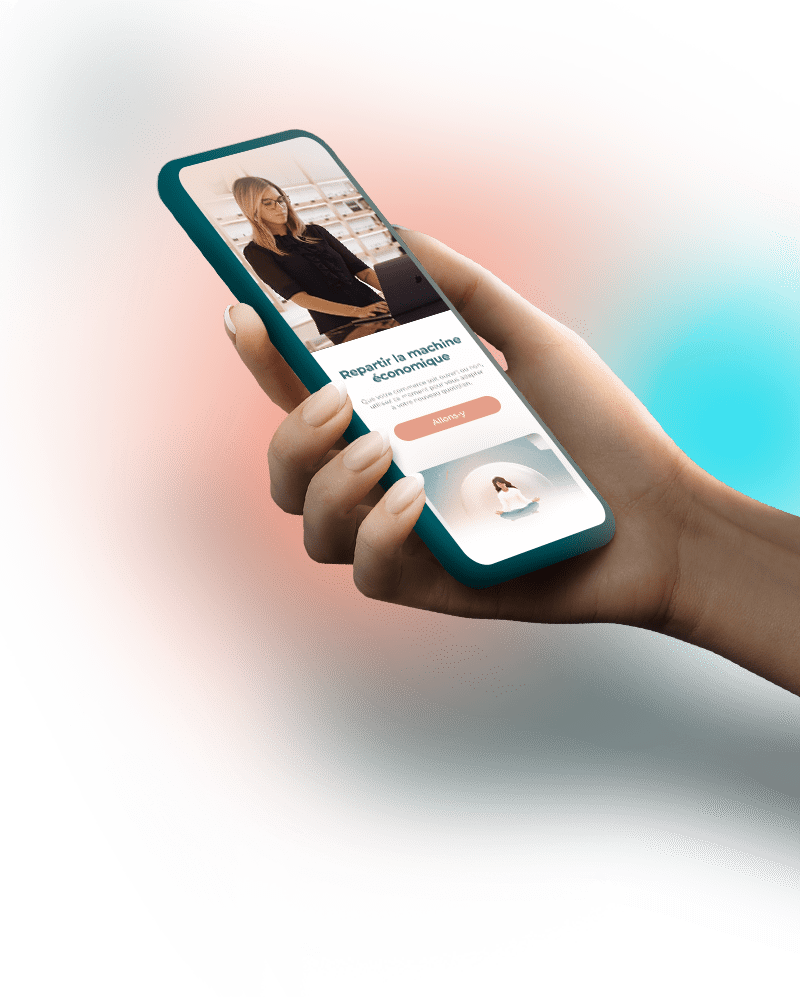Shifting to digital HR processes brings major efficiency gains and makes it easier to centralize information—even for small businesses. Paperless document management isn’t just for large companies.
Stacks of paperwork are piling up on your desk? Time-off requests seem to vanish into thin air? Do you get that feeling that you’re running an archive room rather than a business?
You’re not alone. And when you consider that 65% of printed documents are thrown out or recycled the same day, it’s easy to see how paperwork can quickly become more of a burden than a tool.
In this article, we’ll walk you through practical ways to take the digital leap for your HR processes and switch to paperless document management.
Improve your workflow, save time, all while reducing errors and lost documents—with paperless document management.
What Is Paperless Document Management in HR?
Going paperless in HR means switching to digital tools to handle records and administrative tasks such as hiring, staff scheduling, and handling time-off requests. The goal isn’t to eliminate paper entirely, but to reduce its use in favor of more efficient and secure solutions.
Here are a few common examples of paperless practices:
- E-signatures for employment contracts
- Secure filing of employee records
- Centralized internal communication
- HR software to manage schedules, leave, and work hours
- Online employee database with organized storage of key HR documents (contracts, performance reviews, supporting documents, etc.)
Why Choose Paperless HR Processes?
Paperless document management is a practical, efficient, and modern way to simplify the administrative side of HR—especially for small business managers. And no, you don’t need to be tech-savvy to benefit from it.
Here are a few key advantages:
1. Save Time
Digital systems let you pull up an employee record, time-off request, or contract in just seconds. No more digging through filing cabinets or searching your inbox. It’s a real time-saver—especially when things get busy.
Real-life example: At Bar Renard, a restaurant in Montréal, scheduling and requests used to be handled through Facebook messages, emails, and Excel spreadsheets.
📌 Since switching to Agendrix, employees can check their schedules in real time on their phone, and managers no longer have to answer the same questions over and over again.
2. Cut Costs
Printing, paper, ink cartridges, printer maintenance… These costs add up fast. By reducing—or even eliminating—these expenses, businesses can reinvest in more strategic areas.
On average, companies spend $725 per employee per year on printing. That’s money poorly spent that you could save by switching to online forms.
Real-life example: An independent clothing store that still prints every work contract and time-off request could easily save hundreds of dollars each year.
📌 By going paperless, they also free up valuable space in their already limited back office.
3. Keep Employee Data Secure
Privacy laws like Quebec’s Law 25 require strict control over data access, backups, and security. A digital platform makes it easier to log access, automate backups, and reduce the risk of losing or duplicating sensitive documents.
Real-life example: In a home care clinic, employee records often contain confidential information like certifications, schedules, or even medical details.
📌 A secure paperless system limits access to authorized staff only—keeping your business compliant and your data protected.
4. Improve Hiring and Onboarding
Digitizing your hiring process—from receiving applications to signing contracts—helps speed things up, centralize key information, and create a smoother onboarding experience. It also leaves a better first impression on new hires.
Real-life example: At a small neighborhood pharmacy, a new employee recently had to show up in person just to fill out hiring paperwork and provide their check specimen. With a paperless document management system, the documents could have been sent in advance—securely and hassle-free—for both the manager and the employee.
📌 Modern tools let you start onboarding before day one.
5. Enhance the Employee Experience
Giving employees self-serve access to schedules, time records, and HR policies builds trust and transparency. Instead of waiting on a manager, they can find what they need—when they need it.
Real-life example: At a sporting goods stores chain, employees can check their schedule, flag availability issues, and request time off—all from their phone.
📌 The result: fewer follow-ups for managers, more autonomy for staff, and a better-informed team.
6. Make HR Info Easier to Access
Managers can review and approve time-off requests on the go, right from their phone. Anytime, anywhere access means quicker responses—especially helpful in small businesses where multitasking is part of the job.
Real-life example: A convenience store owner manages schedules across multiple locations. When an employee calls in sick, they can adjust the schedule remotely—no need to be onsite or print out a new sheet.
10 Steps for Paperless Document Management
Switching to paperless HR can feel like a big leap—especially when old habits are deeply rooted. But with a gradual, structured approach, it’s entirely possible to make lasting changes without disrupting daily operations.
Here are the key steps to get started:
1. Assess Current HR Practices
Before moving to paperless HR, take stock of your current processes. This helps identify pain points, recurring issues, and areas for improvement.
Here are a few questions to feed your reflection:
- What type of HR documents do you still keep in paper format? (e.g. contracts, time-off requests, performance reviews, timesheets)
- Where and how do you store these documents? Can you retrieve them quickly when needed?
- Which HR tasks do you still perform manually? (e.g. signatures, tracking attendance, managing schedules)
- How much time do you spend on these administrative tasks each week?
- Have you ever lost an important document or missed a deadline related to HR?
- Can employees easily view their schedules, time off requests, or HR documents?
- What common frustrations slow you down day-to-day? (e.g. errors, delays, oversights)
- Do you already use any digital tools? Are they fully integrated, or could they be used more effectively?
2. Define Roles and Responsibilities
In small businesses, there isn’t always an HR department—but that doesn’t mean HR tasks should be left to chance.
Assign clear responsibilities to avoid missed steps, duplicated efforts, or confusion.
Make sure:
- Every task has a clear owner—whether it’s updating employee records, handling time-off requests, or managing file access.
- The people in charge are comfortable using the digital tools you’ve implemented.
- Privacy and compliance rules are followed, especially by limiting access to sensitive data to those who truly need it.
- Important follow-ups are handled on time (e.g. contract renewals, legal deadlines, policy updates).
3. Digitize Your Existing Documents
Before going fully paperless, it’s important to digitize the HR documents you already have.
Start by identifying important paper documents, then scan them using a scanner or a secure mobile app. As you import them, organize files clearly—by employee or by document type—using consistent folder structures. This will make future searches much easier.
Common HR documents to digitize include:
- Employment contracts
- Hiring forms
- Onboarding documents (e.g. signed internal policies)
- Performance reviews
- Disciplinary notices or official letters
- Records of employment or proof-of-employment letters
- Timesheets or hour logs
- Time-off or leave requests (previously on paper)
- Medical notes or supporting documents
- Employee emergency contacts
- Training or professional development reports
- HR policies (dress code, code of conduct, etc.)
If you’re not sure where to start, try a small-scale test: digitize only time-off requests or work contracts and observe the impact. It’s an easy, low-risk way to validate the benefits before rolling out the process company-wide.
Digital Tools Worth Considering
Cloud storage platforms: Google Drive Entreprise, Dropbox, Microsoft OneDrive, or any HR software with document management features like Agendrix.
Scanning apps: Adobe Scan, Microsoft Office Lens, CamScanner.
4. Replace Paper Forms with Digital Forms
One of the easiest and most effective ways to cut down on paper use in HR management is to digitize the forms you use every day. Whether it’s time-off requests, availability or hiring forms, these documents can be replaced by digital versions accessible anytime from a computer or mobile device.
Common paper forms to digitize include:
- Time-off or absence requests
- Availability forms
- Hiring or onboarding forms
- Schedule change requests
- Incident reports or feedback forms
- Performance evaluation sheets
- Digital Tools Worth Considering
- Form-building tools: Google Forms, Typeform, Microsoft Forms, or HR software with built-in online form creators such as Agendrix.
5. Implement Electronic Signatures
E-signatures not only reduce paper use but also improve efficiency and traceability.
They are legally recognized across Canada, provided they meet requirements for integrity, authenticity, and consent. Many reliable and secure tools can help you comply with these standards without hassle.
Check out this article to learn more about electronic signatures with Agendrix.
Digital Tools Worth Considering
Electronic signature technologies: DocuSign, Dropbox Sign, PandaDoc, Adobe Sign, or integrated solutions within software like Agendrix, which allow you to manage and track document signatures in real time.
6. Automate Repetitive Tasks
Many HR tasks, while necessary, take up valuable time when done manually. Automating recurring tasks helps reduce administrative workload, lower the risk of errors, and speed up internal processes.
Examples of HR tasks that are easy to automate:
- Deadline reminders for probation periods, contract renewals, or annual reviews.
- Automatic notifications when a form is received or approved (e.g., time-off requests).
- Automatic archiving of signed documents or updated employee records.
- Tracking time and attendance.
- Sending welcome or reminder emails during employee onboarding.
- Generating regular HR reports.
Digital Tools Worth Considering
Software like Agendrix offers multiple features integrated directly with scheduling, attendance tracking, and employee document management.
7. Centralize Information in a Single Tool
When HR data is scattered across Excel files, emails, paper forms, and various apps, maintaining a clear and up-to-date overview becomes a challenge. A single digital environment simplifies management, reduces the risk of duplication, and makes tracking easier.
A centralized system brings together everything in one place: employee records, work schedules, timesheets, time-off requests and tracking, internal policies, documents to be signed, key HR communications, and more.
Investing in quality HR software lets you consolidate your HR operations on one user-friendly platform—and makes it easier to automate your processes.
Digital Tools Worth Considering
Software like Agendrix brings together scheduling, time tracking, leave management, internal notes, and employee files in a single, easy-to-use platform.
8. Keep High Security Levels and Protect Your Files
Going paperless with your HR documents comes with major advantages—but it also means greater responsibility when it comes to data security. Employee records contain sensitive information, so it’s essential to implement strict measures to protect their confidentiality, integrity, and availability.
To boost security, consider using a password manager, which securely stores and protects all your login credentials in one place. It allows you to use strong, unique passwords without having to remember them all. Enabling multi-factor authentication is also highly recommended.
Digital Tools Worth Considering
Password managers: 1Password, Bitwarden, Dashlane.
9. Educate and Train your Team
Going paperless with HR processes isn’t something you can do alone—it relies largely on your team’s buy-in and participation. Clearly explain the benefits of the change, guide employees through the transition to digital tools, and offer support as needed. Make yourself available to answer questions and help those who need more time to adjust.
You can also create a digital document management policy to define new standards: folder structure, file naming conventions, access rules, retention periods, etc. This ensures a consistent and effective use of your digital tools over the long term.
10. Evaluate and Adjust
Going paperless with your HR processes is an ongoing journey—it doesn’t end once your tools are in place. Take the time to assess how well they’re working, gather feedback from your team, and make adjustments to your tools or methods as needed.
For example, based on your observations, you might:
- Refine certain workflows or automations.
- Offer a quick refresher training.
- Reorganize your digital filing system.
- Adjust access permissions or approval flows.
- Try out new digital tools.
It’s time for your filing cabinet to retire—finally!
You don’t need to be a multinational to modernize your HR management. In fact, the smaller your business, the more impactful a digital shift can be.
Software like Agendrix makes the transition easier than ever by bringing together schedules, time-off requests, employee records, and internal communication—all in one place. Less paperwork, fewer oversights, less stress—and most importantly: more time to focus on people, not just paperwork.
What Is Paperless Document Management in HR?
Paperless document management in HR means replacing printed documents with online versions accessible through digital tools. This includes digitizing contracts, employee records, and HR forms, as well as automating certain administrative tasks using specialized software.
What Are the Benefits of Paperless Document Management in HR?
Paperless document management offers several advantages:
- Saving time
- Reducing errors
- Improving data security
- Making information more accessible
- Cutting printing-related costs
It’s also a tangible step toward more sustainable and professional management.
How to Transition From a Paper-Based HR System to a Digital One?
The key is to take it one step at a time. Start by assessing your current practices, digitize important documents, switch to online forms, and implement electronic signatures. It’s also a good idea to invest in a centralized tool to manage all your HR processes in one place.
Is It Possible to Combine Paperless Document Management With Traditional HR Processes?
Yes, a hybrid approach is possible. Some companies choose to digitize part of their processes while keeping certain paper-based elements. However, the more centralized and digital your HR management is, the more efficient and consistent it will be in the long run.
What Are the Steps to Transition From Traditional HR Management to a Paperless System?
Here is an overview of the key steps:
- Assess current practices.
- Digitize existing documents.
- Implement e-signatures.
- Replace paper forms with digital ones.
- Centralize information.
- Define roles and responsibilities.
- Automate repetitive tasks.
- Ensure data security.
- Train and raise awareness among your team.
- Regularly evaluate and adjust.
How Can Paperless Document Management Improve Internal Communication Within a SME?
A digital system enables fast and consistent distribution of information—such as policies, documents, and updates—while reducing oversights and information loss. It also allows for more structured exchanges, making it easier to keep everyone informed regardless of their location or work schedule.
How to Involve Employees in the Transition to a Paperless Work Environment?
Clearly communicating the goals of the change, demonstrating the tangible benefits (time savings, easier access, less paperwork), and providing appropriate support and training are just a few ways to engage employees in the transition to a paperless work environment. A caring and gradual approach helps ensure lasting adoption of the new tools.
Which Software Solutions Are Suitable for Paperless HR Document Management in an SME?
Several software options can help ease the transition to paperless HR management while fitting the practical needs of SMEs. Agendrix is a comprehensive and user-friendly solution that centralizes scheduling, leave management, attendance tracking, employee records, and internal communication—all within a single, intuitive platform.


